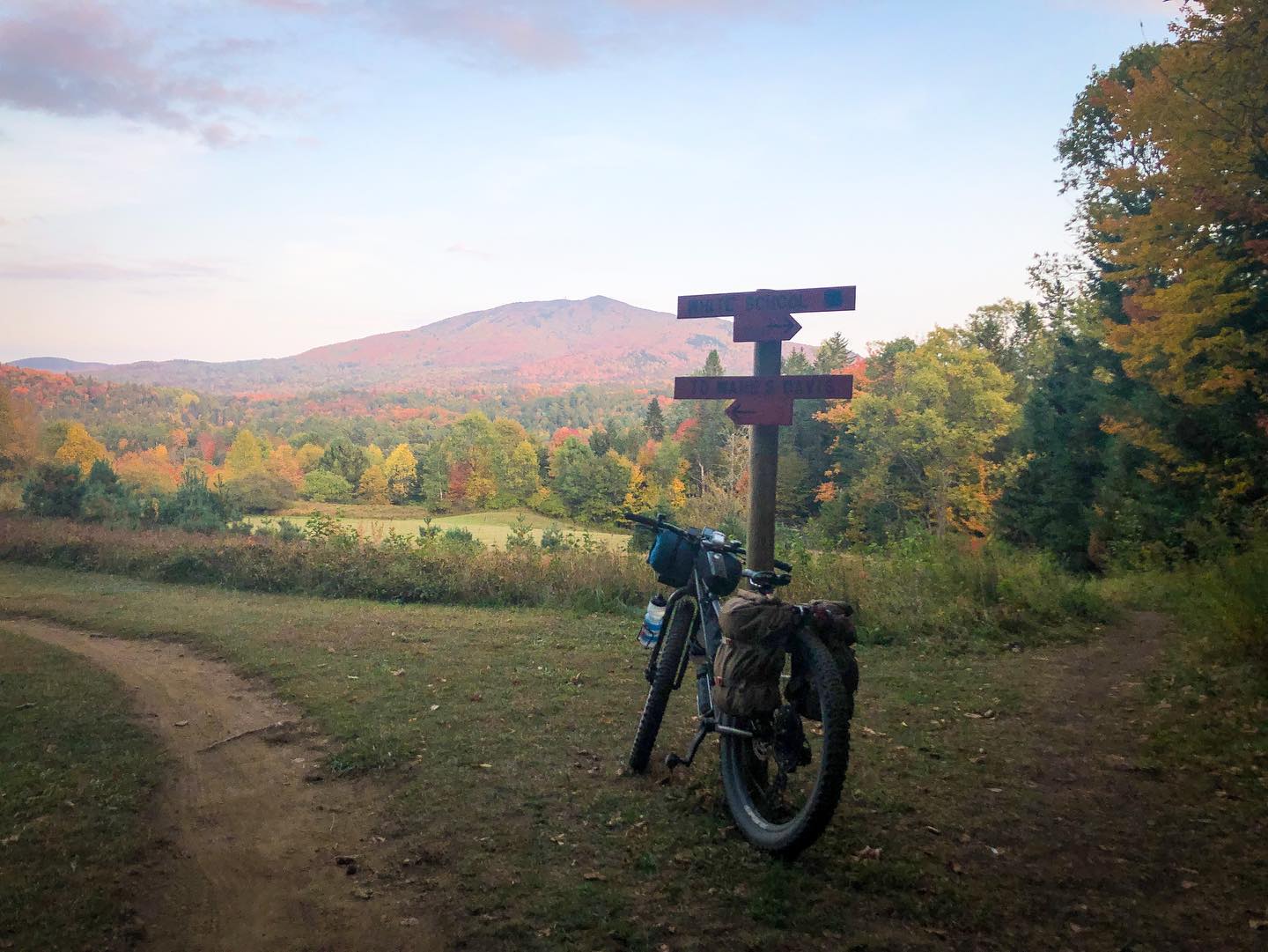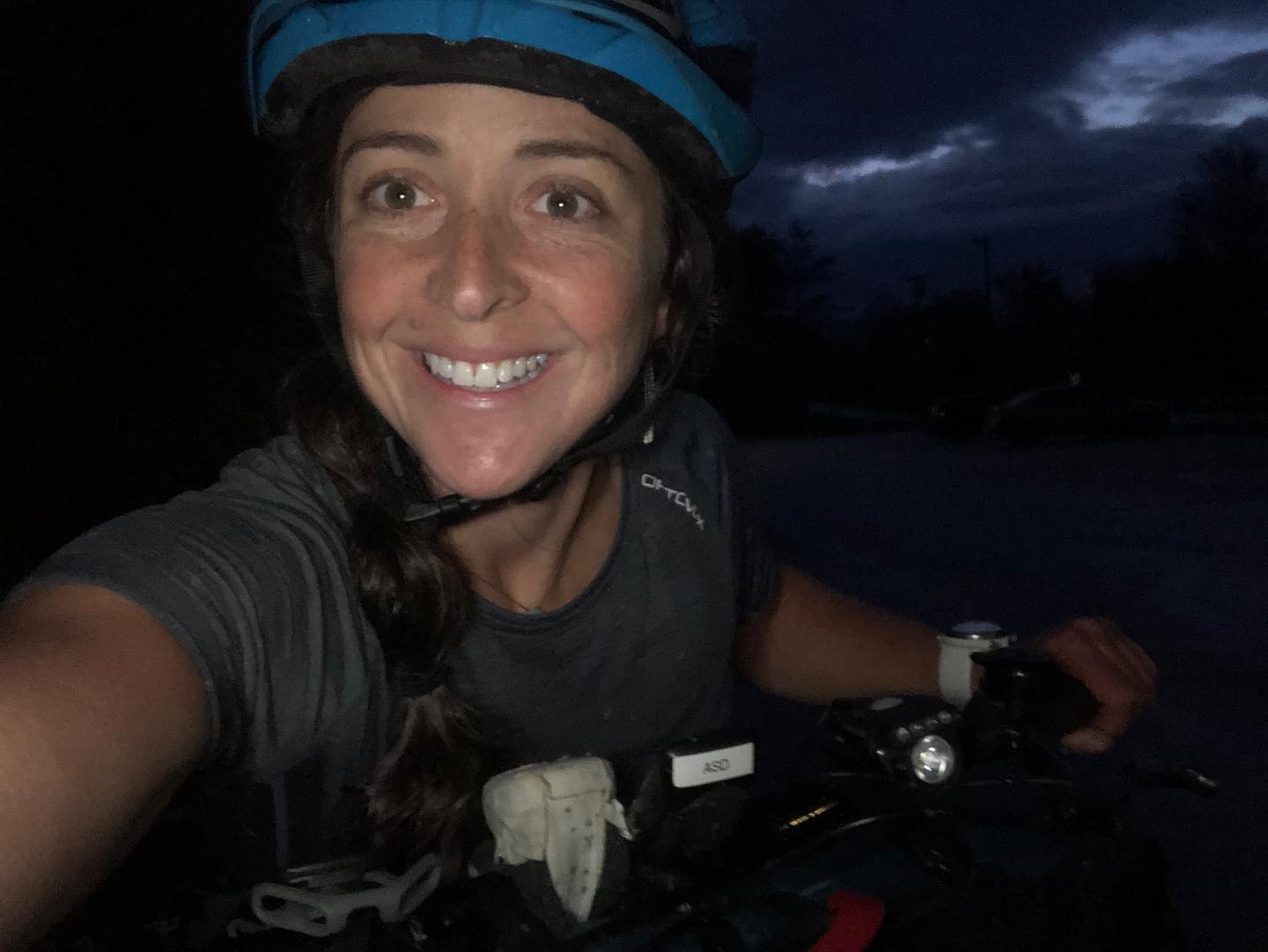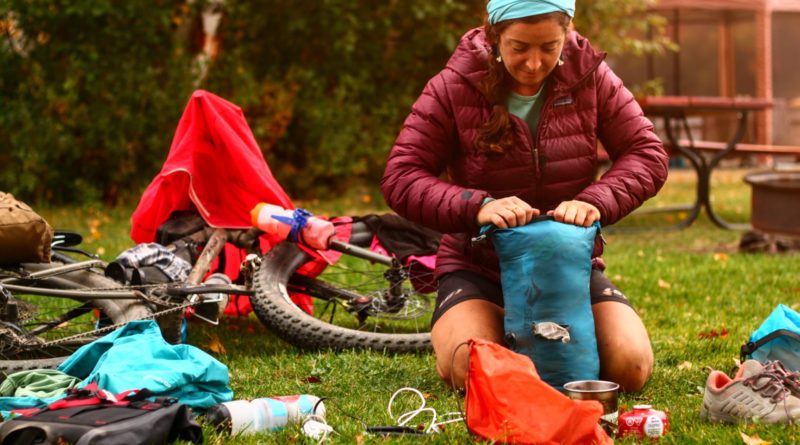Super8’s Super Star
Name: Brittni Gorman Age: 34
Profession: Film producer at Pixela Pictura Films
Partner: Jon Nicolodi
Sports: Backcountry skiing, climbing, bikepacking, ultra running.
Lives in: Jackson, N.H.
When we caught up with Brittni Gorman by phone, she and her partner Jon Nicolodi were traveling south in her tiny home on wheels to meet up with a friend in Asheville, N.C. to do a “35- to 65-mile” adventure run. Not a race, just a route the two friends had planned and the distance would depend on “what feels right.” That’s how Gorman rolls.
While she’s an accomplished ultrarunner and all-around endurance athlete, what Brittni Gorman loves best is setting her own challenges and strategizing how to get from Point A to Point B on a creative route.
So when Gorman heard about the 2020 Super8 Grand Depart, a self-supported endurance ride/bikepacking adventure that covers 645 miles of trails, unmaintained roads and dirt tracks around Vermont, she signed up and headed to the start in Montpelier last September.
Though she considered stopping after doing the first, upper loop of the figure-eight course, and thought about quitting several times after that, Gorman persevered. Of the 17 men and women who started, only four completed the course. To her own surprise, Gorman finished first.
Camping along the way some nights and riding straight through on others, she rode the 645 miles with 60,000 feet of vertical gain in 8 days, 10 hours and 30 minutes, finishing a full day ahead of the next finishers, Matthieu Tschiegg and Chase Duffin.
The 2021 Super8 group “grand depart” happens this Sept. 24 and this time Gorman will be there to film it as part of a one-hour documentary she’s making about the event and the people whose lives it impacts.
Super8’s STAR
Name: Brittni Gorman Age: 34
Profession: Film producer at Pixela Pictura Films
Partner: Jon Nicolodi
Sports: Backcountry skiing, climbing, bikepacking, ultra running.
Lives in: Jackson, N.H.
When we caught up with Brittni Gorman by phone, she and her partner Jon Nicolodi were traveling south in her tiny home on wheels to meet up with a friend in Asheville, N.C. to do a “35- to 65-mile” adventure run. Not a race, just a route the two friends had planned and the distance would depend on “what feels right.” That’s how Gorman rolls.
While she’s an accomplished ultrarunner and all-around endurance athlete, what Brittni Gorman loves best is setting her own challenges and strategizing how to get from Point A to Point B on a creative route.
So when Gorman heard about the 2020 Super8 Grand Depart, a self-supported endurance ride/bikepacking adventure that covers 645 miles of trails, unmaintained roads and dirt tracks around Vermont, she signed up and headed to the start in Montpelier last September.
Though she considered stopping after doing the first, upper loop of the figure-eight course, and thought about quitting several times after that, Gorman persevered. Of the 17 men and women who started, only four completed the course. To her own surprise, Gorman finished first.
Camping along the way some nights and riding straight through on others, she rode the 645 miles with 60,000 feet of vertical gain in 8 days, 10 hours and 30 minutes, finishing a full day ahead of the next finishers, Matthieu Tschiegg and Chase Duffin.
The 2021 Super8 group “grand depart” happens this Sept. 24 and this time Gorman will be there to film it as part of a one-hour documentary she’s making about the event and the people whose lives it impacts.
How did you become an endurance athlete?
I’m originally from Massachusetts, and I grew up hiking and playing outside. I went to Endicott College to study interior design but I wasn’t really an athlete. Then, after college, I moved to Colorado. I lived out there for about five years and started biking and climbing. I was in Breckenridge for a year and then in Boulder for about four years. Out there, I learned how to ‘play’ outside a little bit differently and started to appreciate how to move in the landscape. That led to ultrarunning and I completed my first 50k when I was 30.
What brought you back East?
I wanted to be closer to home but I enjoy being in the mountains so in 2017 I moved to the Jackson, N.H. area. I met some great people in the outdoor community there and it was very easy to start exploring the White Mountains and what they had to offer.
You raced in Last Skier Standing, the Black Mountain, N.H. endurance skimo event the past two years and finished 10th out of 82 this year, beating a lot of men.
Yes, the first year I did 13 laps – so basically skied uphill and downhill for 13 hours. This year my goal was to ski for 24 hours and I managed to ski for 28 hours. There were so many amazing women who did the event and four of the top 10 finishers were women.
What are some of your other endurance events?
I’m not necessarily interested in speed but recognizing your progress, and seeing how you can push yourself mentally and physically at the same time. I also like finding routes I can connect. So, a few years ago, as a fundraiser for SheJumps I mapped out this route where I could run, bike and climb. I started at Pinkham Notch at about 4 am and ran over Mt. Washington, then dropped down to the Cog Railway side where I had stashed a bike. Then I biked on the road over to Zealand to the trailhead, and then ran from Zealand over to Mount Lafayette, and down to Franconia. From there, friends met me and we climbed The Eaglet and descended in the dark. My friend drove me back to where my truck was parked. I think it was a solid 24 hours from start to finish.

Tell us how you got into doing the Super8?
Some friends had done it and I’d been thinking about it so about a month before the event I decided I was going to do it. I bought a Garmin GPS and learned how to use it, packed my Surly with panniers, drove to the Grand Depart in Montpelier and decided to give it a try.
What were some of the best and /or worst moments?
I left the Canadian border on the north end of the first loop around 9 pm and decided I was going to bike to the next camp in Eden. That meant I would be riding over Bayley Hazen Notch in the dark. I was terrified to ride in the dark and I had a lot of self-talk all day to prep myself for it. And then I ended up having a lot of fun. I put on Brandi Carlisle, turned my music up and tried not to think about the animals in the woods and the eyes that were watching me. And then I really got into the flow and I realized I was facing my biggest fears. Then, when I finally to the campsite in Eden at about two in the morning and there was this trail magic: Daniel Jordan, the Super8 founder, was there. He’d been watching my progress and he came up and said “Do you want a grilled cheese sandwich?”
The other hard part was running into a German Shepherd. I was way out in the woods on the southern loop with no cell service when this dog ran up to me barking and growling and he was seconds away from just lunging at me. The owner of the house didn’t come out. I got off my bike and tried to keep it between us as I moved off the property. I know he was just guarding his territory but if he had attacked me no one would have been around to help. After I got away, I stopped and just cried for about 10 minutes. It was terrifying. I now carry pepper spray with me.
How much did you sleep during the route?
The first night I slept, the second I biked through the night and the third night I was back at my truck in Montpelier. That was a really low point and I was thinking about quitting. I didn’t realize how hard it would be. But I slept on it. And the next morning I asked myself if I had really given this a chance. I realized then that I hadn’t given this everything I could. Honestly, it wasn’t really until Day 5 that I stopped thinking about the options to bail.
What was the terrain like?
The southern part was much harder and out of Montpelier, it was really hilly. A lot of the route is on ATV trails and some of it is so techy or steep you can’t really even ride it. I did it on my Surly Karate Monkey hardtail and the bike weighs a lot and I had panniers loaded on the back. But I also had plus-size tires which made some of the roughest sections of a seven-mile-long old carriage road near Bennington with large chickenhead rocks not so bad.
Were you racing to win?
I didn’t have any idea how I was doing until sometime in the southern loop when someone texted me that I was in second. Then I thought, Ok, now I guess I should really try. But what I soon realized is that what I needed to do was just go my own pace and listen to my body because you never know what’s going to be ahead. Then, I got another text that the leader had scratched.

What were the best parts?
There were mornings when it was quiet and the mist was rising and there were green hills and foliage and cows grazing in the fields. That was amazing.
And then there were the people along the way. That was the best part, just meeting them and seeing, for the most part, how generous they were.
I think it was about Day 5 when I had been riding three hours in the rain and I had no cell service when I pulled into Pete’s Camp and had this conversation that totally changed the event for me.
Pete is this incredibly generous person who has a cabin and campsite on his land where he lets bikepackers and others traveling the back roads stay for free. He calls us all “guests of Vermont.” I camped there that night and decided that the next morning I was going to find cell service and call someone to come pick me up.
Well, Pete showed up that next morning while I was brushing my teeth and crying and we had this incredible heart-to-heart. He didn’t tell me what I should do but said “What can I do to help you keep going?” It was just so sincere and that connection is what helped me get going on this project to make a film about the experience.
Tell us about your documentary film about the Super8.
This year I won’t be racing because I will be filming a feature-length film about the Super8. We’ll be out there on bikes and following different riders but also talking with them about how they got ready for the event. Mentally and emotionally, it’s so different for everyone. I didn’t do a lot of prep and only decided to do it a month out but some people had been planning for six months and it’s really interesting to look into how people go about these events and why they choose to spend their 10 days or so of vacation bikepacking. Part of the story is the community that’s formed here and how it brings people together who might not normally cross paths except for this event.
What else did you take away from the experience?
Part of the game is you are constantly shifting things and continually learning what your thresholds are. There’s a lot of talking to yourself and saying, ‘ok, I’ve been here before and this too will pass but here’s what will help me to get from Point A to Point B. And it’s really about simplifying things and knowing what your needs are and how to express them and if that’s something you can do on your own or that you need help with.
So much of that correlates to our lives and even our relationships. At some points on the trail, I think: Ok I’ve been here before in a relationship. Or in a relationship, I think: Ok, I’ve been here before on the trail and that familiarizes these feelings and makes them a little more approachable when you are in that situation again.
The event is not just about sharpening your skills as an athlete but as an individual and a human and how to better yourself in all aspects of your life. —L.L.


Pingback: Vermont Sports 2021 August Issue - Vermont Sports Magazine